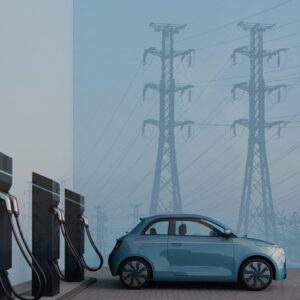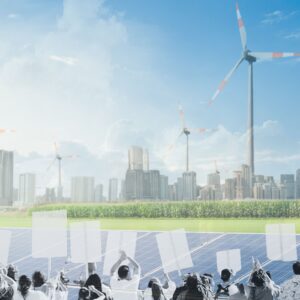Solar and low-income energy assistance programs have long been seen as incompatible. With the recent boom in the solar energy market, however, these programs have begun to converge. Increased attention to the socio-economic benefits of solar energy has driven the desire to address participatory barriers within the market. Improving the accessibility of solar energy to low-income populations has become a possibility with the onset of the community solar movement. Once a hope, it is now a tangible reality that clean energy will cease to be a luxury in the United States.
Community solar, also known as shared solar, is a fractional ownership scheme that provides the opportunity for multiple customers to “remote net meter” from a single distributed generator. Remote net metering allows utility companies to credit energy generated by a solar array to the accounts of participants/owners. By diversifying the types of customers able to remote net meter, community solar projects have expanded the solar energy market, giving previously underserviced customers access to clean energy. This enlargement in customer base has allowed the U.S. solar energy market to grow rapidly in the past few years.
More than fifty-one percent of all new electric generating capacity in the United States came from solar energy production in the first quarter of 2015. Photovoltaic (PV) installations are projected to reach 7.9 GW by the end of 2015, a twenty-seven percent increase from 2014. While growth will occur in all segments of the solar market, residential market growth will be the most rapid. Experts attribute residential market growth to the rise in community solar programs, particularly those targeting previously underserviced populations, including renters, homeowners with incompatible property, and low-income communities. Before community solar programs, nearly seventy-seven percent of U.S. households were unavailable to the solar market, including low-income households—which compose forty percent of all households in the U.S . According to the Solar Energy Industry Association, shared solar generation will represent forty-nine percent of the distributed generation market by 2020. This increase represents a cumulative market growth of 11.0 GW, and a $16.3 billion in solar energy investment.
By diversifying participation in the solar market, the U.S. has begun to increase the accessibility of solar energy. Solar energy development can alleviate the financial burden of lower income populations, who on average pay 20% of their income on energy bills. Meeting the energy needs of these populations through solar energy is an opportunity for job creation, local wealth generation, and socio-environmental policy development. Achieving further market growth will depend on establishing effective public and community solar policies that target previously marginalized populations. Maximizing low-income participation in community solar programs is critical to the future of U.S. solar energy.
Mechanisms for increasing the participation of low-income households in community solar projects can be separated into four broad categories: private capital and financing solutions, integration of models and programs, education and outreach, and public policy solutions. This final category has been the focus of community solar development in recent months, as it is the most readily used in addressing social welfare for low income populations. Among states advocating for low-income solar access, targeting low-income populations has been an obstacle. In response, many states have chosen to shape eligibility requirements. The ability of programs and policies to realize high rates of low-income participation will depend on the framing of eligibility and participatory considerations.
In mid-September 2015, the State of California passed AB 693, the Multifamily Affordable Housing Solar Roofs Program. AB 693 targets low-income citizens through a focus on multiunit affordable housing complexes, as defined by state law and existing programs. Given the success of the state’s Multifamily Affordable Solar Housing (MASH) program, which provides upfront rebates for solar energy development in underserved communities, using multifamily units as the target population of low-income solar policy may be an effective means of expanding solar market participation. Other states, including New York, have considered different methods of targeting low-income utility customers. A section of the State of New York’s Order Establishing a Community Distributed Generation Program and Making Other Findings—issued on July 17, 2015— has proposed automatic enrollment in community solar programs for all Home Energy Assistance Program (HEAP) recipients. Automatic enrollment schemes would ensure low-income solar access by tapping into a previously defined set of low-income customers. HEAP participants would continue to receive the benefits of the program, alongside the financial and social benefits of clean energy. While the state has not formalized any low-income distributed generation policies, solutions of this type may prove beneficial at realizing market expansion into these communities. Mechanisms employed to access previously untapped populations will be critical in achieving projected solar energy market growth.
While current programs addressing solar energy access have not sufficiently matured for assessment to provide much insight into their efficacy, proper evaluation will be key to assessing the extent to which community solar programs address social barriers to clean energy. While best practices are beginning to be uncovered, ambiguity surrounding aspects of program design and implementation is expected as renewable energy policy has yet to fully integrate with social policy. Timing is a major obstacle in developing effective public solar-welfare programs. Proper outreach to low-income populations takes time. Public programs will need to be evaluated on how well they access, attract, and retain low-income and rental utility customers in the near future.
In the advancement of solar energy generation, addressing issues of energy equity has become possible. Community solar projects have and will continue to provide avenues for solar energy expansion through the inclusion of new customer bases. The expansion of potential solar participants has spurred conversations surrounding the affordability of green living in the U.S.: as community solar continues to fuel the growth of the solar market, low-income utility customers will receive more attention in the clean energy sector. Proper policy mechanisms to increase low income access to clean energy are integral to these efforts.






